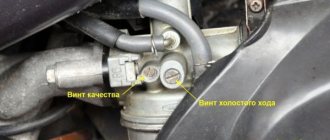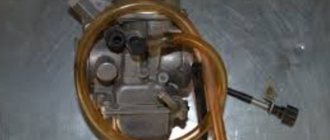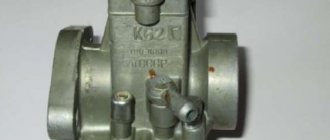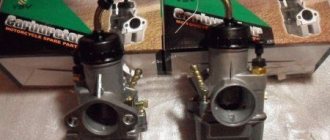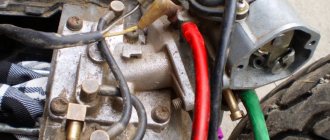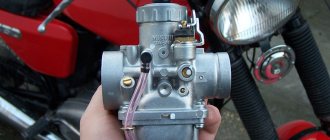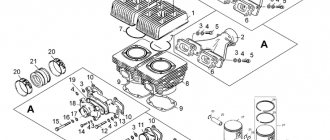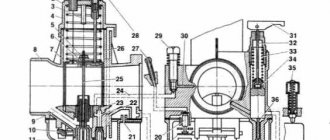In the conditions of mass production of internal combustion engines, it is impossible to ensure perfect manufacturing accuracy; as a result, engines coming off the same assembly line may differ from each other within certain limits. The same situation occurs with the production of engine fuel system elements, in our case, carburetors.
The matter is further complicated by the fact that initially the engine manufacturer does not know in what climatic conditions a specific engine model will be operated. As you know, the same engine will operate completely differently in different climatic conditions.
Designers designing engines are well aware of these problems and therefore introduce adjusting elements into the power system (in our case, the carburetor), by influencing which you can significantly improve the efficiency, power and dynamic performance of your scooter’s engine based on specific operating conditions.
First, a little theory.
As you know, a carburetor is a device in which the working mixture (a mixture of air and gasoline) is prepared, without which the operation of the internal combustion engine is impossible. The most optimal ratio of gasoline and air in the working mixture is the value: 1/15, that is, for 15 kilograms of air there is 1 kilogram of gasoline. With such a mixture, the engine will operate without interruptions and detonation. This mixture is usually called optimal.
Unfortunately, at the optimal mixture, the scooter engine in some modes will not be able to operate stably, for example: in cold start mode, for stable operation the engine requires a mixture in which there is slightly less air than in the optimal mixture, the ratio of such a mixture is: 1/13, that is For every 13 kilograms of air there is 1 kilogram of gasoline. This mixture is usually called “rich”.
In order to enrich the mixture at the right time, additional modules (starting enrichers) are introduced into the carburetors, which are essentially mini carburetors; more details about the operation of the starting enricher are written in the article: Automatic starting enricher for a scooter
The most dangerous for engine operation is considered to be a lean mixture (a combination of gasoline and air of approximately 1/17 or lower. When the engine operates on such a mixture, detonation occurs and overall engine overheating, which ultimately leads to burnout of the piston or cylinder head gasket, melting of the internal surface of the cylinder head, such “little things” as burnout of the exhaust valve need not be mentioned at all.
We place the scooter on the central stand, provide free access to the carburetor adjustment elements, and warm up the engine (a prerequisite for high-quality carburetor adjustment).
We begin the process of setting up the carburetor by adjusting the idle speed. For this purpose, there is a special bolt on any carburetor (marked with an arrow), by rotating which you can increase or decrease the idle speed. By rotating the idle speed bolt, we achieve minimum, but at the same time stable engine speed.
After adjusting the idle speed, we proceed to adjusting the quality of the mixture. For this purpose, the carburetor has a mixture quality bolt (marked with an arrow), by rotating which you can change the composition of the mixture within certain limits. On different models of carburetors, the “quality” screw works on a different principle: in one case, the “quality” screw closes the air channel of the idle system, thereby reducing or increasing the amount of air in the mixture (enriches or leans it), in another case, the “quality” screw regulates the amount of ready-made mixture (emulsion) entering through a special channel into the engine intake manifold.
In general, there is no particular difference between the two principles of operation of a “quality” bolt, except that in the first case, when tightening the screw, the mixture becomes richer, and in the second, when tightening the “quality” screw, the mixture becomes leaner, keep this point in mind.
We determine the correctness of adjusting the quality of the mixture as follows: after adjusting the quality bolt, we give sharply full “gas” (preferably while driving), the engine should confidently develop speed without jerking delays and detonation, a pronounced “catch” should be felt. If the engine unsteadily picks up speed, detonates or stalls when the throttle is suddenly closed, then you should once again adjust the position of the quality screw until the engine begins to develop speed with a pronounced “catch”.
If, after adjusting the quality screw, it is still not possible to achieve normal operation from the engine, then we try to lower or raise the carburetor needle in increments. If the engine picks up speed poorly (rich mixture), lower the needle; if the engine picks up speed unsteadily, detonates and stalls when the throttle is closed abruptly, raise the needle. Try to raise and lower the needle one division at a time and not immediately all the way up or down.
You can read more about the structure and adjustment of the needle in the article: Photo report: Design of the carburetor of a four-stroke scooter (carburetor 4t) or in the article: Photo report: Disassembly and design of the carburetor of a two-stroke scooter (carburetor 2t).
Next, after all that has been done, we drive the scooter for several kilometers as usual, unscrew the spark plug and visually determine by the color of the spark plug insulator what mixture the carburetor is “preparing.”
If the spark plug insulator is black and covered with a layer of soot, then the carburetor is “preparing” a “rich” mixture, in this case the situation can be corrected by lowering the carburetor needle to the desired division.
If the spark plug insulator is snow-white, it means the carburetor is “preparing” a “lean” mixture, in this case the situation can be corrected by raising the carburetor needle to the required division.
If the spark plug insulator is sand or brick-colored, then your carburetor is preparing the optimal mixture and no further adjustment is necessary.
After the final adjustment of the carburetor, you should adjust the free play of the throttle cable; for this purpose, there is a special nut on the cable by tightening or tightening which you can reduce or increase the free play of the cable. The free play of the throttle cable should be: 1-2 mm.
On some models of scooters equipped with 2T engines, after final adjustment of the carburetor, the positions of the oil supply control drive should be adjusted. To do this, just like in the first case, we look for the adjusting nut on the oil supply system drive cable and tighten and release the nut until the marks (marked by arrows) are opposite each other.
Adjusting the carburetor on a 2t scooter: setting it up together
We continue to discuss DIY motorcycle repairs.
The carburetor has been cleaned, the next step is to adjust the carburetor of the 2t scooter. Over the summer, you have to adjust and adjust the operation of the engine several times.
Anyone who is at least a little familiar with the structure of the carburetor will be able to set it up on their equipment themselves. On 2-stroke engines, carburetors are adjusted according to the same principle. Therefore, the topic will be of interest to owners of any brand of 2t 50cc scooters. Whether you have a Honda Dio 27, 34, 35, stroke, Yamaha Jog, BVS or other 2-stroke mopeds.
Diagnostics
Before installing the air filter, turn on the ignition and jerk the kickstarter foot several times until the engine starts.
If it does not start, then the most common reason is that the cold start system is malfunctioning.
We check this way: cover the carburetor hole with your fingers to maximally enrich the mixture with gasoline, and continue to push the kickstarter.
If the engine starts and the speed does not drop during operation, then look for the reason in the cold start system.
If the cold start system is working properly, then after starting the engine the speed will rise and gradually, within 10 minutes, begin to fall. On a warm engine, gradually unscrew the large screw (amount of mixture) until the speed drops to medium, confident idle.
At the same time, drops of gasoline should not splash or pour out of the carburetor.
If gasoline splashes out of the air supply hole, this indicates a malfunction of the reed valve in the engine. Then the valve needs to be removed and cleaned or replaced with a new one.
And if gasoline leaks out, this indicates a high level of gasoline. Adjust the float level and ensure the needle valve is sealed.
Methods for adjusting and tuning a scooter carburetor
The carburetor is an important part, without which the engine will not work. How to set up the carburetor on a scooter determines how smoothly and correctly the engine will run and whether it will be possible to start it in cold weather. The task of this unit is to mix gasoline with air in certain proportions, resulting in the formation of a working mixture, the composition of which determines the behavior of the power unit. The standard ratio should be 1 to 15, if you need the scooter to idle well, you can lean the mixture a little by making 1 to 13; enriched mixture - 1 to 17. For a more in-depth study of the design of a scooter carburetor, we recommend reading the article “The design of a scooter carburetor and the principle of its operation.” Well, now let's learn everything about adjusting the 2-stroke and 4-stroke carburetor of a scooter.
Scooter: adjust the carburetor with your own hands
One of the main components in the fuel mixture supply mechanism in a vehicle such as a scooter is the carburetor. Before moving directly to the description of the adjustment process, let's talk about why it is needed at all.
Carburetor - a device that ensures the formation and supply of a fuel mixture (consisting of air, gasoline and oil) directly to the engine
What exactly is the purpose of a carburetor? In a nutshell, this is a device that ensures the formation and supply of a fuel mixture (consisting of air, gasoline and oil) directly to the engine. That is, the quality of this mixture and, accordingly, the power that the power unit produces depends on it.
Scooters typically use carburetors of a type called “float” carburetors. The main element is a Venturi tube, which houses a damper that regulates the amount of air supplied to the mixture, as well as a needle that supplies gasoline. By unscrewing the throttle, we thereby open the throttle and raise the needle, increasing the amount of air-fuel mixture entering the engine.
Naturally, the movements of the valve and the needle must be clearly synchronized to ensure its (mixture) homogeneity. The float chamber is designed to ensure the constant presence of gasoline in the tube. The principle of its operation is based on the fact that when the fuel level drops, the float lowers and opens a channel for supplying gasoline to the tube. When it is full, the float rises and closes the valve, thereby stopping the flow of fuel.
If the scooter's engine power drops, it is impossible to start the engine or the engine stalls - these are signs of a carburetor failure
Signs that the carburetor is faulty may include:
- Engine power drop
- Inability to start the engine
- The engine stalls.
Another way to assess the quality of the carburetor (more precisely, the correctness of its operation) is as follows - unscrew the spark plug and look at its color. If it is white, it means the fuel mixture is lean, that is, there is too much air in it, and if the spark plugs have a black tint, it means the carburetor is “pouring” too much fuel. With any of these options, one thing is clear - it needs adjustment.
It should be noted that, globally, this process does not depend on the engine stroke, therefore the answer to the question of how to correctly adjust the carburetor on a Chinese 4t scooter and how to correctly adjust the carburetor on a 2t scooter will be the same. Let's now move on to describing the sequence of actions.
This is interesting: On the road, the traffic police inspector took a photo of my driver’s license. Does he have the right to do this and why did he do it?
How to adjust the carburetor on a scooter
Knowing how to adjust the carburetor on a scooter, you can get rid of many problems, make sure that the vehicle starts immediately, runs smoothly and does not fail in hot or cold weather. For this, the carburetor, depending on the model, has either only a needle or special adjusting screws.
Adjusting the carburetor on a scooter, if there are adjusting screws, occurs as follows: when the screw is rotated clockwise, the mixture becomes richer, and counterclockwise, accordingly, it becomes leaner.
The procedure must be carried out in the following order:
You also need to take into account little things that may be present on some scooter models, but not on others. For example, before adjusting the carburetor, you need to check the condition of the fuel filter. If it is very dirty, it is recommended to replace it, since even if the carburetor is new and well tuned, a clogged filter will prevent the mixture from flowing in the correct proportion.
The question of how to adjust the carburetor if you have the popular Japanese scooter Honda Dio is quite relevant. Regardless of the year of manufacture and type of carburetor, the scheme described above will suit it.
Idle speed adjustment
Idle speed adjustment plays an important role. When the engine warms up well, you can begin this procedure. To do this, you will need to rotate the adjusting screw clockwise. Its location depends on what model of scooter and carburetor you have. If you don’t know the exact location, find the description instructions for the installed model, where it will be written where which screw is located. For example, on a Honda, the original carburetor has such a screw in the center; on the left side you can find an adjustment for the quality of the mixture.
Adjustment is not difficult: you need to do it with the engine warm and running. When you tighten the screw, the speed will increase, and when you unscrew it, it will decrease. When the engine runs smoothly, you need to stop rotating the propeller. This must be done smoothly, after each change in position, let the engine run a little
Adjusting the mixture quality
Depending on the position of the needle in the carburetor, the percentage of gasoline and oxygen also changes: if there is a lot of air in the mixture, this can be seen by the spark plugs. They will turn black and a characteristic soot will appear. If, on the contrary, there is not enough air, a white coating appears on the candle, and it is clear that the electrode is melting. And this. and that’s not very good for the engine as a whole, not to mention the fact that you will have to change the spark plugs often. Before tuning, you need to unscrew the spark plug and examine its condition, from which you can already build on it, enriching or leaning the mixture.
Not only the operation of the engine, but also its condition depends on the quality of the mixture. For example, with a lean mixture, traction disappears, and with an excessively rich mixture, carbon deposits gradually form in the combustion chamber, which harms the engine. If the carburetor is modern, it has a special screw for adjusting the quality of the mixture, so there is no need to disassemble it. In order to enrich the mixture, the screw must be rotated clockwise; to lean it, rotate it counterclockwise.
The adjustment occurs as follows:
If the carburetor model is old or the screw is missing, in order to debug its operation, you need to get to the needle. In this case, adjustment of the scooter carburetor occurs as follows: there is a special locking ring on the needle. When you raise it up, the mixture will become richer, and when you lower it down, it will become leaner. Typically from the factory the retaining ring is in the middle. Having pulled out the needle with your fingers or tweezers, we move the ring and reassemble the carburetor. After this, you can start the engine and see how it works. If necessary, adjust the settings to perfection using adjustment screws.
Adjusting the fuel level in the float chamber
The fuel level in the float chamber plays an important role. This part is located inside the carburetor, where the process of mixing gasoline with air takes place. In addition to the free reservoir, it contains a float, jets and a needle valve. It is the position of the float that determines when the valve is closed and, accordingly, whether the carburetor will overflow or not. If there is too much gasoline, the engine will start to stall because the spark plug will get wet and the spark will not be able to ignite the mixture.
The reasons why the carburetor on a scooter overflows are usually the following:
The first two problems can be solved by cleaning the carburetor. You cannot use metal objects for this; You can arm yourself with a soft rag. Particular care should be taken when handling jets. The inside can be cleaned with a thin copper wire, but this should be done carefully. The second problem is solved by bending the tongue. It is quite fragile, so you can use your fingernail or tweezers, being careful not to break it. It is easy to check whether the float is positioned correctly: it should be parallel to the body, and not tilt up or down. Then, when fuel enters the chamber in the required amount, the float will rise, and the valve will block the flow of excess fuel into the chamber. Why a scooter carburetor overflows can be found in more detail here.
How to adjust the float in the float chamber on a scooter?
To do this, you need to use a nozzle: it is located at the bottom of the chamber. The screw must be unscrewed, but in such a way as to prevent gasoline from leaving the tube. Usually it is located below the nozzle; if the tube is transparent, it will be more convenient to carry out the work. In order to see the fuel level, it must be raised vertically.
At a normal fuel level, gasoline does not reach the curb of the carburetor cover, at a higher level it begins to overflow, at a lower level the scooter rides poorly and nods. To adjust, you will need to disassemble the carburetor, find the needle inside the float chamber, there is a locking ring on the needle, it needs to be moved down.
In the mountains
Audi 80 Audi RED MATT Logbook FOR SALE Manifold for horizontal carburetors. VWAudi 8valve Dbilas
The composition of the mixture produced by the carburetor also depends on barometric pressure. This is well known to anyone who has driven in the mountains - engine power quickly decreases with ascent. Why? Firstly, due to a decrease in air density, the weight charge of the fresh mixture in the cylinder decreases; secondly, this mixture itself becomes too rich. According to data given in the literature, with increasing altitude the mixture is enriched by approximately 6 percent for every thousand meters. When driving up a mountain road, you need to change the carburetor adjustment from time to time. Most carburetors do not have special height correctors that allow the mixture to be properly leaned—only partial load modes (by lowering the metering needle) and idle modes (with the quality screw) can be adjusted. We are not considering the possibility of replacing the main jet, since for almost all carburetors this work is too labor-intensive. Thus, when the throttle valve is fully opened at high altitudes, the mixture will be over-rich - this must be remembered, especially when, due to a lack of power, every now and then you want to give more “gas”. Overloading the engine at low speeds is completely unacceptable, since an attempt to increase the speed by opening the throttle valve leads to an even greater drop in power, interruptions in operation, or even stopping of the engine. When starting a hot engine, you need to remember that the mixture is very rich, and in order to avoid serious troubles, it is better to forget about the existence of the quencher at this time. Don’t look for unnecessary adventures; there are already enough of them in the mountains.
Starting to move in conditions of a steep climb and lack of power is no less difficult. Sometimes you need to help the engine by pushing the motorcycle, and at the same time select the position of the spool at which the engine pulls satisfactorily and does not “choke.” It is better to get into the saddle while moving, without losing speed, which is already low.
Not all mountain roads run in the sky. Sometimes even at low altitudes they require certain skills from motorcyclists. Very often, motorcycle “aces” who come from lowland areas have a difficult time here. Miscalculation follows miscalculation. They often make mistakes in assessing the steepness of the ascent or descent on mountain passes; it happens that they do not catch the moment when the ascent ends and the descent begins. The high speed of movement and sharp closed turns only aggravate these errors, the reason for which, apparently, should be sought in the absence of the usual “horizon” before the driver’s eyes. It is not found in the mountains. For example, a mountain range rising like a giant wall in front sometimes gives the illusion of a steeper descent than it actually is. Moreover, in fact, at this moment the road may even be ascending. Hence the ridiculous mistakes in choosing the right gear: when the engine protests and, overloaded, begins to lose speed, the driver comes to his senses and... mechanically, out of habit, adds gas! Usually, immediately after this, interruptions in operation begin, because at excessively low speeds, increasing the gas does nothing. After all, if the engine is overloaded, but the throttle valve is partially open, then the air speed above the atomizer may still be sufficient for normal atomization of gasoline (the air passes through a relatively narrow gap). Although the power is small, this is not a “failure”. But if, instead of changing gear, they try to increase the traction force of the motorcycle by adding gas, the power quickly drops. What happens in the carburetor does not even remotely resemble its normal operation. On the one hand, the decreased vacuum worsens the operating conditions of the atomizer and the entire dosing system, on the other hand, low air speed worsens its mixing with fuel, which now enters the engine in a wide variety of forms - from vapors to large drops. Let the reader decide for himself what kind of mixture there actually is in the cylinder—whether it’s rich or lean. And is it even a mixture?
To avoid such puzzles, it is recommended to change gears in a timely manner, avoiding overloading the engine. And the carburetor will not let you down!
Features of setting up the carburetor of a 2-stroke scooter
The carburetor on the 2t scooter is slightly different in design and does not fit the 4t motor. The question of how to set up such a device worries all owners of two-stroke machines.
Most Chinese models have a fairly simple carburetor without unnecessary adjustments. The enrichment here is mechanical, although if you are tuning a scooter or you have a Japanese model, the enrichment can also be electric. In order to use the mechanical option, you must first pull the trigger on it, and then try to start the equipment.
Adjusting the carburetor of a 2T scooter is not difficult, but it does require some patience. In order to do this, you will need to disassemble the carburetor: first you will need to unscrew the top cover. The needle in it is fixed with a staple; it needs to be pulled out. The quality of the mixture is adjusted in the same way as described above. A feature of the push-pull system is that the needle affects the quality of the mixture only in a certain position. If the throttle valve is raised to its maximum, only the main fuel jet will be responsible for the fuel mixture. Sometimes the idle speed system interferes with it. Depending on what carburetor you have installed.
For a cold start, you need to use a starting enrichment, which must be closed after the engine warms up; Simply put, it's a suction. In such carburetors, the fuel level plays an important role. It is also regulated by mechanical intervention in the operation of the float chamber. It is configured in the same way as in the four-stroke version. In fact, the carburetor for 2t engines differs from models for engines on a 4-stroke scooter only in jets and some other parameters, but it is designed similarly, and therefore is regulated in the same way.
Full load mode
15 best motorcycles
The mechanically actuated economizer valve 33 is closed by a spring 34, which presses the ball valve 31 against the seat 30.
The valve opens when the throttle valve is in a position close to its full opening, due to the kinematic connection of the valve with the lever 37, rod 32, rod 21 and bar 20.
In this case, the bar 20, attached to the rod 21, comes into contact with the intermediate pusher 28 through the pusher 17 and moves it down.
The intermediate pusher presses on valve 31, and it moves away from the seat. Fuel passes through hole 27 and enters the main fuel channel 35.
The fuel dosage is carried out by the economizer valve jet, and then goes to the full power jet, the flow area of which is designed to prepare a mixture that provides full engine power.
Features of tuning the carburetor of a 4-stroke scooter
Adjusting the carburetor of a 4t scooter is quite possible with your own hands and should not cause any difficulties, the main thing is to act according to the instructions described above. It’s not always possible to adjust; the carburetor on a 4t scooter works right away. You will have to be patient: you may have to repeat the procedure several times until you get a result that suits you. The smooth operation of the engine, the ability of the vehicle to start in cold weather, and what kind of piston wear will depend on how to correctly configure the carburetor in a 4t scooter.
4T scooters are usually equipped with similar carburetor models, so the VLC carburetor adjustment scheme described above is also applicable to other types of devices.
Results
Despite all the difficulties and apparent complexity of the device, adjusting the carburetor on a scooter is possible both at home and in the field. It is recommended to carry it out at least once a season, especially during frosts - this will avoid flooding the candle. If your old engine starts to feel bad, adjusting the carburetor can extend its life. Although the moped will lose a little power. And yet, with the help of proper carburetor settings, you can make life much easier for yourself and your iron horse.
